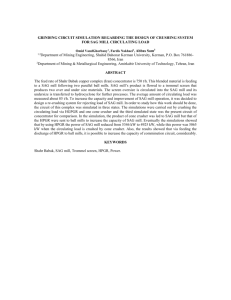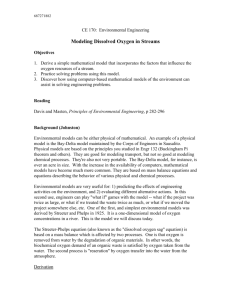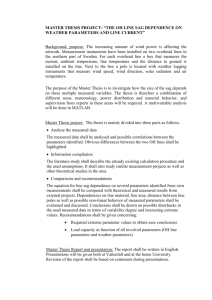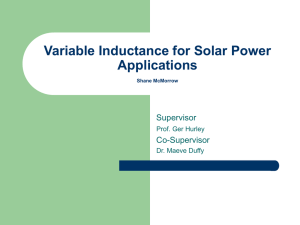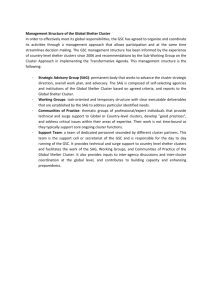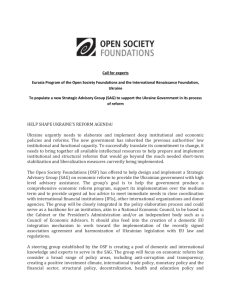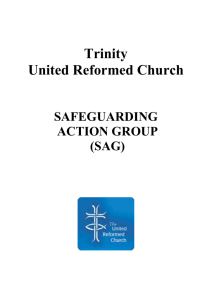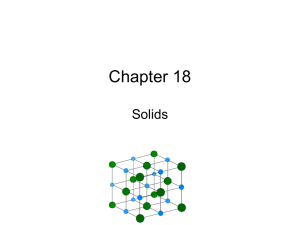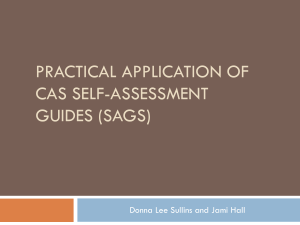CITY OF TORONTO: LONG-TERM WASTE MANAGEMENT
advertisement
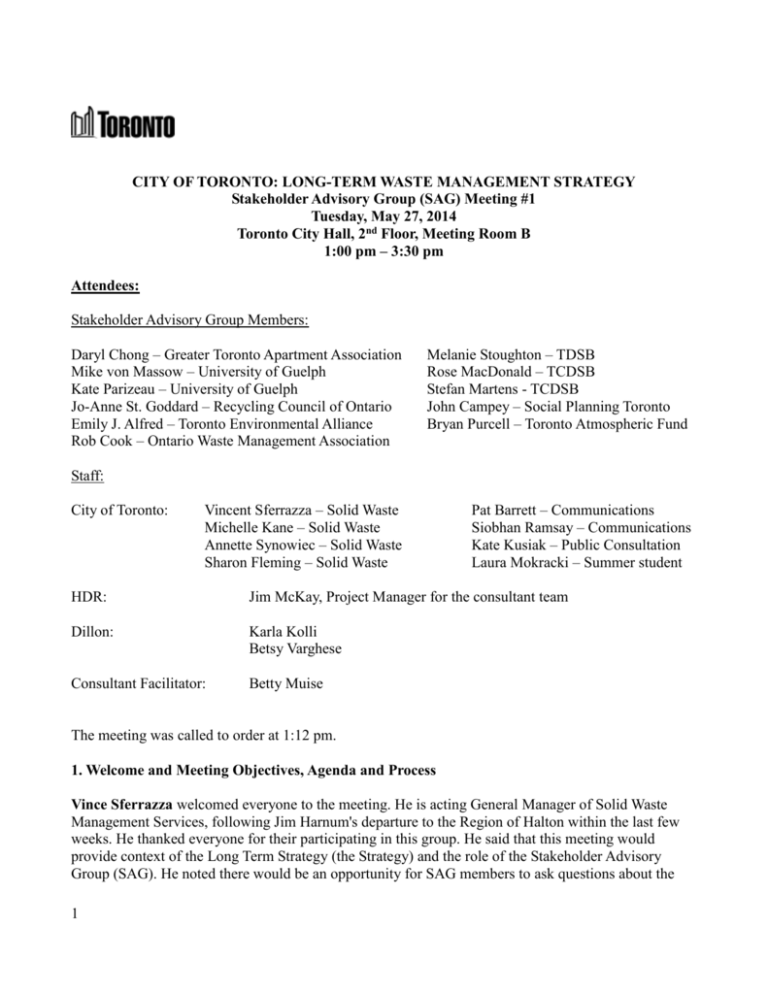
CITY OF TORONTO: LONG-TERM WASTE MANAGEMENT STRATEGY Stakeholder Advisory Group (SAG) Meeting #1 Tuesday, May 27, 2014 Toronto City Hall, 2nd Floor, Meeting Room B 1:00 pm – 3:30 pm Attendees: Stakeholder Advisory Group Members: Daryl Chong – Greater Toronto Apartment Association Mike von Massow – University of Guelph Kate Parizeau – University of Guelph Jo-Anne St. Goddard – Recycling Council of Ontario Emily J. Alfred – Toronto Environmental Alliance Rob Cook – Ontario Waste Management Association Melanie Stoughton – TDSB Rose MacDonald – TCDSB Stefan Martens - TCDSB John Campey – Social Planning Toronto Bryan Purcell – Toronto Atmospheric Fund Staff: City of Toronto: Vincent Sferrazza – Solid Waste Michelle Kane – Solid Waste Annette Synowiec – Solid Waste Sharon Fleming – Solid Waste Pat Barrett – Communications Siobhan Ramsay – Communications Kate Kusiak – Public Consultation Laura Mokracki – Summer student HDR: Jim McKay, Project Manager for the consultant team Dillon: Karla Kolli Betsy Varghese Consultant Facilitator: Betty Muise The meeting was called to order at 1:12 pm. 1. Welcome and Meeting Objectives, Agenda and Process Vince Sferrazza welcomed everyone to the meeting. He is acting General Manager of Solid Waste Management Services, following Jim Harnum's departure to the Region of Halton within the last few weeks. He thanked everyone for their participating in this group. He said that this meeting would provide context of the Long Term Strategy (the Strategy) and the role of the Stakeholder Advisory Group (SAG). He noted there would be an opportunity for SAG members to ask questions about the 1 strategy, the City and its programs, and staff would do their best to answer those questions. This group will be instrumental in producing a strategy to guide decision-making pertaining to Solid Waste Management over the next 30-50 years. Consultation with a broad spectrum of stakeholders has played a significant role in similar types of activities of other municipalities in the GTA, like Hamilton, York, and Peel, and the City of Toronto recognizes the value of public consultation and the importance of the contributions of the many stakeholders in this policy. He advised that SAG members will receive three Council reports that provide the background to this project. This initiative began in March 2013, and after two more reports, the consultant was hired. A video about Toronto Solid Waste Management Services was shown to the group to provide some more background information. Betty Muise, the facilitator of the meeting, introduced herself and explained her role as one of service to the SAG and to the City, to help them meet their common goals. She described herself as like a “traffic cop” to ensure that the meetings are productive and effective in meeting their goals when there are diverse views in the room. She described the objectives of today's meeting: “Build a strong foundation for the effective operation of the Stakeholder Advisory Group and kick off the SAG process by providing an orientation to the current City of Toronto waste management status and the proposed long term waste management strategy.” She reviewed the day's agenda with the group. One of the main focuses of the day will be when the SAG reviews the public consultation materials for upcoming Public Information Centres (PICs). This part of the meeting is intended to give an overview of Toronto's waste management to the group, and also to invite SAG members to provide comments about these materials to staff. She also reviewed the guidelines of the SAG's meeting process: Staying on track and on time. Meetings will be starting on time in order to end on time; No one person or issue hijacks the agenda; Group negotiates any changes; Fair, respectful dialogue and listening is expected – people should bring their perspective to the table, but not their agenda. She introduced the concept of a “Parking Lot”, which is a list of items that come up during the meeting to be addressed in another venue, such as one-on-one, at a later meeting, or off-line. 2. Introductions 2.1 Introduction of Attendees Participants were invited to introduce themselves and the organizations they represent, and to describe why they were participating in the SAG: Jo-Anne St. Goddard is the Executive Director of the Recycling Council of Ontario. She said she is 2 pleased to participate as her organization is always looking for opportunities to encourage and support municipalities in improving waste diversion. Though much waste management is regulated provincially, there is a lot municipalities can do on their own to improve diversion. Darryl Chong is the President of the Greater Toronto Apartment Association, which represents private sector rental properties in the City. He recognizes that apartments will be a major focus of the strategy. Most Toronto apartment buildings were built in the 1960s or before, when these issues were not yet contemplated, so they are a challenge, but he is happy to be here and is willing to participate and help how he can. Vince Sferrazza noted that multi-residential sector now makes up about 50% of households in Toronto. Brian Purcell is a program director at the Toronto Atmospheric Fund (TAF.) TAF is an arm-length agency from the City whose mandate is to assist the City to reduce Green House Gas (GHG) emissions and meet Climate Change targets that Council has set out. The City has already met and exceeded its 2012 goal of reducing 1990 emission levels by 6%. Many of those reductions have come from better management of emissions from solid waste including the organics program. He is here to see if more emission reductions can be made in this sector. Vince Sferrazza affirmed that the City will be taking a holistic approach, incorporating other environmental considerations, such as Climate Change, into the strategy. Melanie Stoughton is from Facilities Services of the Toronto District School Board (TDSB). Her department is responsible for 580 sites in Toronto, and services that include the EcoSchools program and managing waste from those sites. The TDSB has a long term and reciprocal working relationship with the City of Toronto and is interested in helping the City meet its long term waste management goals. Emily Alfred is from the Toronto Environmental Alliance (TEA), which is a non-profit environmental organization of 40,000 Torontonians. TEA has been working on solid waste issues for a number of years and it represents Torontonians of many backgrounds. She sees solid waste as a good entry point for many people to environmental issues, since everyone at some point needs to figure out which bin to put their waste in. Rose MacDonald and Stefan Marten are both representing the Toronto Catholic District School Board (TCDSB). They want to ensure that there are no increased costs because school boards have limited funding and a lot of money is spent on waste management. They look forward to contributing to the discussion as well. Vince Sferrazza recognized that some of the stakeholders are customers, and Solid Waste Management is sensitive to that. Mike von Massow and Kate Parizeau are from the University of Guelph. Their work focuses mainly on food waste, and especially household waste. They are trying to figure out what types of waste is coming out of houses and which behaviours lead to higher or lower volumes of food waste. They also work with restaurants to understand their food waste. They are here to learn and share what they have learned. They are building relationships with other municipalities as well. Kate Parizeau is also interested in recycling systems. 3 John Campey is Executive Director of Social Planning Toronto, which is an unofficial trade association for non-profit organizations. Their first engagement with the City's Solid Waste division was regarding a decision that imposed user fees for garbage on their membership. They have been working with the City on this issue, and he is hoping to take advantage of the network of organizations who are interested in affecting positive change both in the development of the strategy and in its implementation. He is also interested in bringing issues of poverty and equity to the discussion. Vince Sferrazza affirmed that the “triple bottom line” will be determining the direction of the strategy. Rob Cook represents the Ontario Waste Management Association, which represents both private and public sector organizations that provide a wide range of services in the waste management sector. They are active in pursuing good waste management policy, and they are pragmatic in that they don't have a preferred solution but are open minded to finding the right solution. He participated in the New and Emerging Technologies team and he knows this process will be a marathon session, but he is confident it will be worth it in the end. Vince Sferrazza noted that some stakeholders could not attend this meeting, including Toronto Community Housing, TABIA and University of Toronto. Staff members were also introduced, as per the staff list at the top of the minutes. 2.2 Introduction to the Long Term Waste Management Strategy Sharon Fleming gave an introductory presentation about the Long Term Strategy (see attached presentation, Appendix 1). Vince Sferrazza noted that there are a lot of background materials, such as the consultation plan and communications plan, but staff did not want to overwhelm the group with information. However, there will be more opportunities in the future for examining the documents that have been and will be produced. He wanted to clarify that the process of developing the Strategy will not be looking at siting facilities, , Environmental Assessments or vendor selection. The City is not yet ready to look at those details. As the group progresses and reviews options, the consultants will provide information about the technologies, such as the impacts, regulatory requirements, permits that the operator must receive first, etc. This will guide decisions in the future, but the specific details will not be worked out as part of this strategy. A SAG member noted one of the factors to evaluate options should include how difficult it would be to achieve community buy-in. Vince Sferrazza agreed. A SAG member also wanted to know what the 30-50 year horizon means: whether the horizon will be decided during the process or if there are two horizons? Vince Sferrazza answered that it is a range that was given to the consultant. He recognized that a lot can change in twenty years, but he accepted that it is a good question whether there should be different levels of review for 30 and 50 years. This issue was placed in the “Parking Lot” as it is an issue to be revisited during the process. Jim McKay added that a typical longer term plan encompasses 20-25 years, since it is difficult to achieve accuracy beyond that. However, progressive long term plans also incorporate a long-term vision of up to about 4 50 years, to provide a sense of where the plan is heading. 3. Purpose and Functioning of the SAG Terms of Reference (ToR) The facilitator noted that before the meeting, participants should have received a draft ToR that describes how the SAG is supposed to operate. More copies were available at the meeting. Staff would like to move towards having signed agreement of the ToR. A sheet was passed around for SAG members to sign to indicate that they accept the ToR. The facilitator highlighted some points of the ToR, including that value is added to the strategy by gathering informed input from a broad spectrum of perspectives. She also noted that this is an advisory group, and that responsibility for final decision-making rests with the City. She also noted some logistics, including that the full duration of the SAG goes from this meeting until the summer of 2015, with up to 17 meetings. A draft agenda and information materials will be distributed one week in advance of the meeting. Meeting notes will be provided one week after and they will be attributed. She also highlighted that the ToR lays out some meeting practices which are similar to the practices she had laid out earlier for this meeting. The facilitator invited participants to raise questions or concerns. A SAG member wanted to know if the attributed notes would be made public. Vince Sferrazza stated that the Freedom of Information Act likely means that the notes will be available to the public and possibly to the media as well. He noted that the team may be a need to address issues of how to communicate with the media and the public. A SAG member noted that as per the Municipal Freedom of Information and Privacy Act (MFIPA), since members are present as representatives of organizations, the information is open to a Freedom of Information request (whereas private individuals are not open to these requests). The facilitator asked if attribution of comments would inhibit free discussion. A SAG member noted that as a representative of an organization in which there are sometimes diverse views, she would often seek council within the organization, so she would want to know how much information she could reveal before receiving council. She can be flexible in seeking opinion, but she needs to know the circumstances under which she is speaking. A SAG member noted that she also represents a group who will be interested in the proceedings of the meeting. She knows that her group will be asked by the media about the SAG. She also wanted to know about the clause of the ToR that commits participants from not expressing opinions about the proceedings. The facilitator noted that the ToR mentions that participants may not express an opinion on behalf of the SAG. A SAG member wanted clarification if City staff would be compelled to release confidential information. Annette Synowiec said staff could check about this and let the group know 5 within approximately a week by e-mail. A SAG member requested confirmation that participants could express opinions on behalf of their organizations. Vince Sferrazza reiterated that participants may express the opinions of their own organizations, not that of the SAG. The facilitator noted there had been a question about whether it is sometime possible to say things during the SAG meetings that would be off the record. Vince Sferrazza noted that the issue of attribution in the notes is going to be under review. Staff want participants to be able to speak freely, so staff will reconsider this for the next meeting. The issue was put in the “Parking Lot” and will be dealt with again at the next meeting. 4. Orientation and Our First Review During this item the SAG reviewed the Public Information Centre (PIC) panels. The facilitator asked participants to fill out the worksheet “SAG Review of Draft PIC Stations” with their comments about each of the stations (except Station 1, which is a Kids' Zone). Staff wants to know if they met their stated goal and if there are any required improvements. All materials are still subject to change – nothing is yet finalized. Staff want to know if they are communicating effectively. Participants should focus on higher level comments, but have the opportunity to take copies of the panels away to provide more detailed comments through e-mail later. Betsy Varghese noted that they would like comments back by Friday, May 30. Karla Kolli presented a “roadmap” of the public consultation materials and described how it fits into the public consultation program (see attached presentation, Appendix 2). She said that Dillon worked with City staff to create an all-encompassing plan to generate awareness and effectively consult with stakeholders and the public to share information and obtain input on the strategy. She reviewed the three phases of the strategy. In the first stage, the primary objective is to generate interest in the longterm strategy and provide educational resources about the background and reasons for the strategy. The objective of the second stage will be to get feedback on the options that are being generated. The objective of the last phase is to get feedback on the collectively created strategy. She described how staff is trying to avoid creating a typical PIC by providing a comprehensive process of many different avenues to consult, including presentations, workshops, and a strong on-line presence. Staff don't want to overwhelm the public with too many panels. They want to make it more welcoming. She showed a map of information stations that participants will receive when they arrive, and which helps them decide where they want to go. Each station provides a specific type of information. Staff want the information to be interesting and interactive, so that people can participate in learning. It has been designed to allow participants to get a lot of attention from staff and to allow many opportunities for participants to provide comments and input to the team. Betsy Varghese noted that providing a Kids Zone will help to reduce the barrier to having parents participate in the PIC, and will allow children to learn and parents to have the opportunity to participate in the other stations. 6 Participants walked over to a display of the draft panels for Station 2. They viewed the panels for the other stations using smaller printouts and on the projector. The following is the discussion about the panels for each station. Station 2 The goal for this station is to help people understand why the City is doing a strategy and how the City is doing a strategy. In particular, there is an emphasis on the reasons for the strategy, such as limited land fill capacity, and the changing nature of waste. A SAG member noted that the words “waste” and “garbage” are used interchangeably and said that is a bad use of the terms. Betsy Varghese said they will define waste as recycling, compost and garbage in their glossary of terms that will be provided at the back of the PIC Station map. Vince Sferrazza said that they are trying to speak the language of the lay public. A SAG member said that they tend to use the term “materials” with adjectives such as “waste materials” or “recyclable materials” to distinguish between them. A SAG member said for educational purposes TEA tends to use the language of the City bins (“garbage” vs. “recycling” and both as “waste”) so that people know what they are referring to. Vince Sferrazza invited participants to let staff know if there are alternative words they would recommend. A SAG member objected to using the term “waste” for recyclables as she believes people think of waste as what goes in the garbage, not recycled. A SAG member asked the City to be consistent in their wording to help them stay on track with their educational efforts. Staff will reconsider the terms used for this. The group considered panels with examples of how much waste is generated and about the differences between the single-family and multi-residential sectors. A SAG member said that the panels should highlight the 50%-50% multi-family / single family household split as it is an important concept for people to understand. Betsy Varghese showed some props (bags of different types of waste) that will be used at the PICs to demonstrate the differences in waste streams by weight and by volume. There will also be an opportunity for PIC participants to write their ideas about their values on a board at this station. A SAG member wants to use the term “solutions” rather than “solution” to emphasize that there will be a variety of solutions and not just one. A SAG member also highlighted the importance of reaching out to different immigrant, language and cultural groups and said that he doesn't think many of these groups will come to formal PICs. He hopes there will be alternative venues for these groups. Annette Synowiec said that the Strategy will be promoted at community events, environment days etc. A SAG member said he can provide some additional suggestions. They agreed to continue this conversation together off-line. Station 3 The goal of Station 3 is to provide a brief history and understanding of the current waste management 7 practices and system. It shows the locations of transfer stations and informs the public about where they can go to take their waste. It also compares Toronto to other cities in North America, highlighting that Toronto is top in terms of waste diversion. There is also a description of the waste hierarchy (Reduce, Reuse, Recycle, Recovery, and Residual Disposal). Staff have also aimed to raise awareness of other City programs. Staff have drawn attention to the fact that not all recyclables make money for the City – sometimes the City has to pay to have it recycled. Other panels describe the organics program and the Green Lane Landfill. The facilitator asked if the objective of this station had been reached. Most people agreed that it had. A SAG member suggested an additional panel about the cost implications (costs vs. benefits) to the tax payer of the various programs to address misperceptions about recycling always costing more. A SAG member suggested that it would be useful to mention private waste that is not part of this waste stream. Annette Synowiec said that private waste collection is not tracked by the City. The facilitator asked if it should be made clearer that this is only about what the City manages rather than private collection, so that people realize this is primarily only the residential sector. A SAG member said he would caution about over-celebrating our success given the amount of waste collected by the private sector. A SAG member agreed that this is a very confusing area (people might recycle different things at work than at home, or in apartments than in houses) and she said that sometimes it is best to avoid the details of this topic. However, she does try to explain that contracted waste services by the City is different than private collection. A SAG member agreed that cost is important to highlight, in order to emphasize the importance of waste reduction. She said this is a good opportunity to highlight what is recyclable now, which is more relevant than what was recycled in the past. Many people want to know what is actually recyclable. A SAG member said that the panels should also include details about all the waste streams. Station 4 The goal of Station 4 is to get participants to understand which options will be explored in the waste strategy, focusing on diversion and disposal. These include: mechanical-biological treatment, which extract recyclables and organics from the waste stream, leaving residuals; thermal treatment in which recyclables are extracted from the ash, and the ash is used for construction or other beneficial uses or sent to landfill; and expanding or purchasing more land for landfill. The team will be getting PIC participants to provide input about what they put in the garbage, and share their own waste diversion tips. The facilitator asked who thought the objective had been met. Most agreed it had. A SAG member said the word “reduction” had not been mentioned anywhere and that people need to think about reduction more. The word “diversion” often gives people permission to throw things out – they don't think about reduction when they hear diversion. 8 A SAG member emphatically requested that non-profit organizations be included in the group of partnerships. Some creative solutions can be found with social enterprises through non-profits. A SAG member asked if “disposal bans” is referring to City collection or the entire city. Vince Sferrazza said he doesn't think the City can institute a disposal ban on those who use private disposal. A SAG member thought it should be clarified that this is only for City collection. A SAG member asked about the charge on plastic bags (and other options to support reduction of waste) and where that would fit in as an option on the table. A SAG member said that it could fit under Waste Management Policies but suggested that municipal policies be included, not just provincial. A SAG member suggested enforcement should be included with Promotion and Education. Vince Sferrazza said that the team should be careful that too much emphasis not be put on “end of pipe” solutions, agreeing that it gives “permission” to put items in the waste stream. More emphasis should be put on behavioural changes. A SAG member suggested getting community input about which options they would want to prioritize. Annette Synowiec agreed that this is important and noted that this will be a major focus of the second round of public consultation. The first round is just to introduce the various concepts, and make the public aware that thermal treatment can now be considered. Station 5 The goal of Station 5 is to ensure participants know how to stay involved. It provides information about the various ways the public can be in touch with staff and keep informed about the strategy as it progresses. Overall comments The facilitator thanked the group for moving past her request not to “wordsmith” by focusing on some key words in recognition that key words can be very powerful in the way they educate and inform. Additional comments should be sent to Annette Synowiec by the end of the week. Annette Synowiec mentioned that starting next week the PICs will be advertized and she encouraged the group to use their networks and organizations to publicize the PICs and encourage people to attend. Annette Synowiec will send communication about the next meeting. Attendees are also welcome to send her suggestions or comments about how the meeting was run and suggestions for the future. Annette Synowiec will be the key contact for general questions, concerns, etc. 9 5. “Parking Lot” A SAG member suggested leaving the 30-50 year as a concept to come back to at some point. He understood Jim McKay's explanation and said it made sense. Vince Sferrazza said that there is a commitment to re-examine the following: clarifying communication with the media, and attribution of comments in notes. Vince Sferrazza said he would send out an email within a week to clarify these points. Action Item: City staff to send e-mail to SAG within one week clarifying the confidentiality clause of the ToR, specifically in reference to communication with the media. It will also address attribution of comments in the notes. A SAG member will be taking the issue of increasing participation off-line with Annette Synowiec. 6. Summary of Actions, Meeting Close and Thanks The facilitator thanked the group and invited feedback about how the meeting went, and how it was run. Vince Sferrazza noted that City Council has instructed Solid Waste Services to report back quarterly. They will provide an information report to Committee on June 18. No actions will be included other than to accept the report for information. The SAG will receive a copy of this report. Vince Sferrazza thanked the group for their participation and their perspectives, and for sharing their opinions. He will be happy to report that this meeting went well. The meeting was adjourned at 3:33 pm. 10

